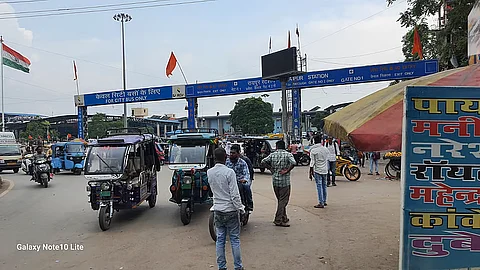

Satya Thakur, 24, spends a total of three hours each day commuting between her home and coaching centre — amounting to 18 hours a week, excluding Sundays.
She lives in Tikrapara, a locality in Raipur, the capital of Chhattisgarh. To travel the 3 kilometres from her home to Jaistambh Chowk, she takes a shared auto or e-rickshaw, a journey that takes about 20-30 minutes. From there, she switches to another vehicle to reach Mowa Bazar, which is 7 kilometres away.
The coaching centre is located 2 kilometres from Mowa Bazar, and since no public transport runs along this stretch, she walks the distance — a 30-minute trek. Under normal conditions, covering the 12 kilometres round trip takes about 3 hours, but traffic congestion often increases this time. Her daily commute also costs her between Rs 60 and Rs 80. Thakur is completely dependent on autos and e-rickshaws to reach her coaching centre, spending three hours daily commuting.
Like Thakur, Manpreet Kaur Maan, a resident of Tatibandh in Raipur, spends two and a half hours daily commuting between her home, workplace, and coaching centre. She works at a pharmacy located at Jaistambh Chowk, seven kilometres from her house. In the evening, she heads to a coaching centre at Vivekananda Ashram, around two kilometres away.
By 8 pm, she catches an auto from there to return home, a 6-kilometre journey that costs her at least Rs 100. Manpreet says she often feels unsafe traveling in autos at night but has no other commuting option.
Chetan Diwan, who has worked as a ward boy at Dr Bhimrao Ambedkar Memorial Hospital in Mekahara, Raipur, for the past 12 years, used a bicycle to commute from Rajendra Nagar for seven years. In 2020, he took a loan from friends to buy a motorbike and has since stopped cycling. He believes Raipur’s roads are not suitable for cyclists.
Shaashwat Shukla from Shailendra Nagar shares a similar story. After an accident three years ago, he abandoned his bicycle and started using a motorbike. In Raipur, very few people use environmentally friendly bicycles.
In contrast, the affluent population in Raipur mostly uses private vehicles. In many households, each family member has their own two-wheeler or car.
Ashok Kumar, a resident of Adarsh Nagar, is a case in point. Retired from a government job at Doordarshan, he has lived in Raipur for 32 years and says he used a city bus only once, around 7-8 years ago, to travel from Tatibandh to his home. That 12-kilometre journey took over two hours, after which he swore never to use the bus again.
Currently, Ashok owns a car and four two-wheelers. His daughter, son, and daughter-in-law — all employed — commute by bike or scooter. He believes two-wheelers save both time and money, which is why most people in his colony prefer them.
Most of Raipur’s residents commute in a similar fashion. Due to a lack of alternative transportation options, dependence on autos and e-rickshaws is at an all-time high. According to the Transport Department, in just the first five months of 2025, Raipur has seen an increase of 1,335 new autos and e-rickshaws.
In the last five years (2021–2025), 10,188 new e-rickshaws have been registered in Raipur. Passenger auto registrations tell a similar story — since 2016, 6,484 have been registered, and their numbers continue to rise each year. Except during the COVID years (2020–21), their growth has been steady over the past decade.
According to Kamal Pandey, President of the Raipur Auto Union, over 15,000 autos and e-rickshaws currently operate in Raipur. He says the working class and lower middle class largely rely on these two modes of transport. With a population of around 1.9 million, over 600,000 residents in Raipur depend on autos or e-rickshaws — meaning roughly every third person relies on them for daily travel.
Pandey believes Raipur’s transportation system is in poor shape because the government has failed to prioritise the issue. He is particularly concerned that the authorities issue licenses to untrained drivers, which leads to traffic disruptions and frequent accidents. Despite repeated appeals to streamline the system, no action has been taken.
E-rickshaws have also become a major source of employment and local income. Many individuals are profiting by renting them out. Sumit Pandey, who operates e-rickshaws in Raipur, told Down to Earth (DTE) that he owns 14 of them. He drives the oldest one himself and rents out the other 13. Each brings in Rs 300-Rs 350 per day, allowing him to earn around Rs 4,000 daily from rentals alone.
When DTE reporters used autos and e-rickshaws to navigate the city, they found no fixed fare system or designated routes. Commuters are often at the mercy of arbitrary charges set by drivers, which leads to daily disputes and frustration.
This article is part of our series on how India moves, which looks at the relationship between air quality and human mobility in cities and towns. This story is the first in the Raipur mobility series. Also read the second, third and fourth parts.